It might seem like a silly thing to think that you can create a business that generates money that you can eventually live off of. And it might also seem silly to think that ideas that have been floating around in your head for years are going to be the catalyst to that money generating business. But it’s not so silly when we can point to data that clearly outlines the repeatable steps that are necessary to succeed.
By the end of the day you will have learned and accomplished 2 very crucial concepts and activities:
1. You will have a clear understanding of what makes a good business/product idea, and
2. You will have done objective data-driven analysis on ideas that were formally validated only by your subjective emotions.
Outline for Day 1:
- Write down your Business/Product ideas
- Use This Criteria to find ideas that deserve your time and energy
- Categorize ideas by Business Objective
- Ranking Ideas
- D.E.F.T Framework (Document, Evaluate, Focus, Test)
- 27 Honest Questions
- Back-of-napkin Financial projections
- First Mile Certainty Analysis
Write Down Your Business/Product Ideas
The very first thing we are going to do is write down our ideas. To be thorough, we are going to start with a broad net. We want to capture everything, including the stuff that we will ultimately dismiss.
Before you start capturing Everything that pops into your head, keep in mind that there are a few criteria that I’ll be using to determine if the idea that I’m exploring is good enough to be explored.
The criteria that I will be using to measure the success of the next 30 days is:
- Profitable
- Sustainable
- Repeatable, and
- Legal
You can see the expanded version of this list in a previous post where I describe and provide an outline to the 30 Day Business process.
So, that excludes certain ideas from the list right away. Including those easy-out solutions like asking family for money selling your possessions to cover your costs. We’re making real businesses that make real money. They will be small at first, but they will be designed to grow.
Action Item: Write down all the business ideas that meet your basic criteria for success.
Criteria for Ideas that deserve your time and energy
I spent some time in a two-part piece talking about Ideas and which ones are worth pursuing. Part 1 talks about how you can know if something is a good idea instead of just an idea that you like. Part 2 talks about what you can do to wrap your arms around ideas that are good and worth pouring your energy into.
I spent some time this morning re-reading from a book called Big Magic by Elizabeth Gilbert (author of Eat Pray Love). The book is less practical than what I typically read, but there was something that stuck with me the first time I read it, and I still think about it often. The core message of the book with the following excerpt.
“I believe that our planet is inhabited not only by animals and plants and bacteria and viruses, but also by ideas. Ideas are a disembodied, energetic life-form. They are completely separate from us, but capable of interacting with us—albeit strangely. Ideas have no material body, but they do have consciousness, and they most certainly have will. Ideas are driven by a single impulse: to be made manifest. And the only way an idea can be made manifest in our world is through collaboration with a human partner. It is only through a human’s efforts that an idea can be escorted out of the ether and into the realm of the actual.
Excerpt From: Gilbert, Elizabeth. “Big Magic.” Penguin Publishing Group, 2015-09-22.
Therefore, ideas spend eternity swirling around us, searching for available and willing human partners. (I’m talking about all ideas here—artistic, scientific, industrial, commercial, ethical, religious, political.) When an idea thinks it has found somebody—say, you—who might be able to bring it into the world, the idea will pay you a visit. It will try to get your attention. Mostly, you will not notice. This is likely because you’re so consumed by your own dramas, anxieties, distractions, insecurities, and duties that you aren’t receptive to inspiration. You might miss the signal because you’re watching TV, or shopping, or brooding over how angry you are at somebody, or pondering your failures and mistakes, or just generally really busy. The idea will try to wave you down (perhaps for a few moments; perhaps for a few months; perhaps even for a few years), but when it finally realizes that you’re oblivious to its message, it will move on to someone else. But sometimes—rarely, but magnificently—there comes a day when you’re open and relaxed enough to actually receive something. Your defenses might slacken and your anxieties might ease, and then magic can slip through. The idea, sensing your openness, will start to do its work on you. It will send the universal physical and emotional signals of inspiration (the chills up the arms, the hair standing up on the back of the neck, the nervous stomach, the buzzy thoughts, that feeling of falling into love or obsession). The idea will organize coincidences and portents to tumble across your path, to keep your interest keen. You will start to notice all sorts of signs pointing you toward the idea. Everything you see and touch and do will remind you of the idea. The idea will wake you up in the middle of the night and distract you from your everyday routine. The idea will not leave you alone until it has your fullest attention. And then, in a quiet moment, it will ask, “Do you want to work with me?”
I love this quote. I love this idea. I don’t know if ideas are independent entities that are searching for a host to bring it to the world, but I absolutely agree that an idea unheeded will eventually leave you and become somebody else’s.
Ideas are powerful. The right idea in the right hands can change the world! The right idea in the wrong hands can destroy a life.
It’s very important to align your competencies with your passions and much as possible when selecting a business/product idea. Something we’ll talk more about when we do the First Mile Certainty exercise later.
Categorize ideas by Objective
Ok, you should have a list of ideas that you’ve created. Your free-form brainstorm had very few constraints – only that they needs to generate some amount of money.
Now we are going to categorize the ideas in to different segments by their objective. This exercise will help you get a better idea of the motivation behind the idea, and what successful deployment looks like.
Answer the following questions about each one of your business/product ideas and place them into one of Business Objective Categories listed below:
- Generate high-volume sales
- Generate high-profit margins
- Create a work environment that is enjoyable
- Take a piece of an existing market
- Enhance your personal brand
- Improve the performance of an existing process
- Solve a specific problem
- Positively impact the world
Your idea might fall into more than one of the categories above. Which perfectly ok, most of the ideas I have fall into more than one category. If your idea doesn’t fall into any of the categories above, create a new category and describe what the objective of the Business/Product is.
Keep in mind, this exercise isn’t asking what you want to do with the money you make from your business/product. having money to spend is definitely a motivation for working hard at your business, but that shouldn’t be confused with the Business Objective of the actives your Business/product will engage in. or what your Business/Product will be used for by your customers.
Action Item: Categorize your business/product idea into the Business Objective categories above.
Ranking your ideas
There are several different ways to rank your ideas – how fun they will be, how cool you will look doing it, how much time investment it will require, how broke you will be if you fail.
Before we get into more rigorous analysis, you need to rank your ideas from best to worst. Use a general measuring method here based on your gut instinct.
Let your best ideas float to the top and the ones that seem silly or impossible should sink to the bottom of your list.
Later we’re going to rank each of your ideas by how much money you can expect to make if each one was reasonably successful over a 12 month period.
But for now, just rank them with the simple metrics of good, better, best. (hopefully you didn’t bring any of your bad ideas with you today…)
Action Item: Rank your ideas from best to worst using Good, Better, Best metrics
D.E.F.T Exercise (Document, Evaluate, Focus, Test)
The DEFT framework is where the real analysis begins. Up to this point, you should have your ideas written down, along with the Business Objective category that each one falls into. You then ranked them based on your gut instinct into good, better, best categories.
The DEFT framework is inspired by “The First Mile: A Launch Manual for Getting Great Ideas into the Market”, Harvard Business Review Press, Scott D. Anthony. Others have articulated the same basic concepts when testing your business hypothesis, but I like what comes next – the 27 Honest Questions that will really put your ideas to the test.
Action Item: Answer the 27 Honest Questions about each one of your business/product ideas.
27 Honest Questions
You can download the attached file that has all 27 questions for you to answer. Feel free to print it out, or answer by writing on the PDF on your computer.
As you answer these questions, you are giving an answer to the best of your knowledge today. Over the course of the 30 days, we are going to learn how to do the market analysis that will yield objective answers to these questions. But first, we are going to familiarize ourselves with these concepts and get our minds thinking about the issues that actually matter when starting a business. Once we’re primed, we will be much more receptive to data and answers that might be different from the ones we came up with on our own.
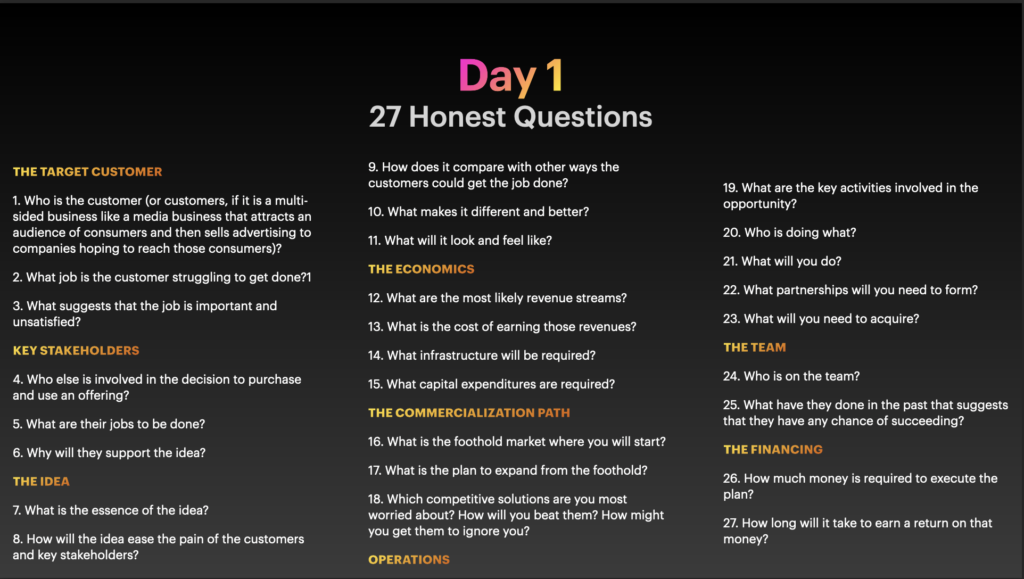
Back-of-Napkin Financial Projections
As we continue to ease into more rigorous analysis of our business ideas and eventually our final business selection, we will do more math. Nothing too sophisticated, mostly simple math like addition subtraction, multiplication, and division. We want to get a general idea of the amount of money we can expect to make if we create the business/product we’re hoping to build.
The backward way of looking at potential income from a business is to set a revenue target and then make up all the numbers that will result in that revenue number. While that would be fun, we wont to do that because it is a little too speculative. What we are going to do is create something called a reverse income statement.
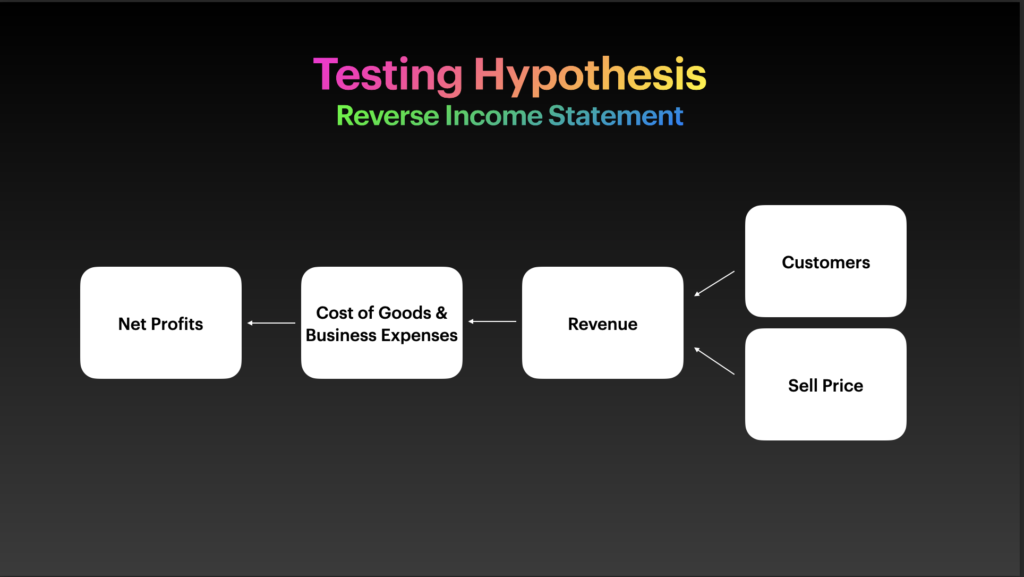
To run your idea through this reverse income statement you start from the right side and move to the left. For the customers box, you will write down the number of people you think will become your customers and pay your money – over a one month period. The sell price is the price per item. These two numbers will give you the Revenue number. After revenue, you will subtract the costs per unit multiplied by the number of units you sold and then subtract the cost of doing business each month. After you’ve subtracted all the expenses, you’re left with Net Profits. This awesome number represents what you get to take home!
But, before you get too excited, lets walk through 2 semi-real scenarios. One scenario with a physical product – like a board game or fidget spinner – and one scenario with a digital product, like a song or piece of software.
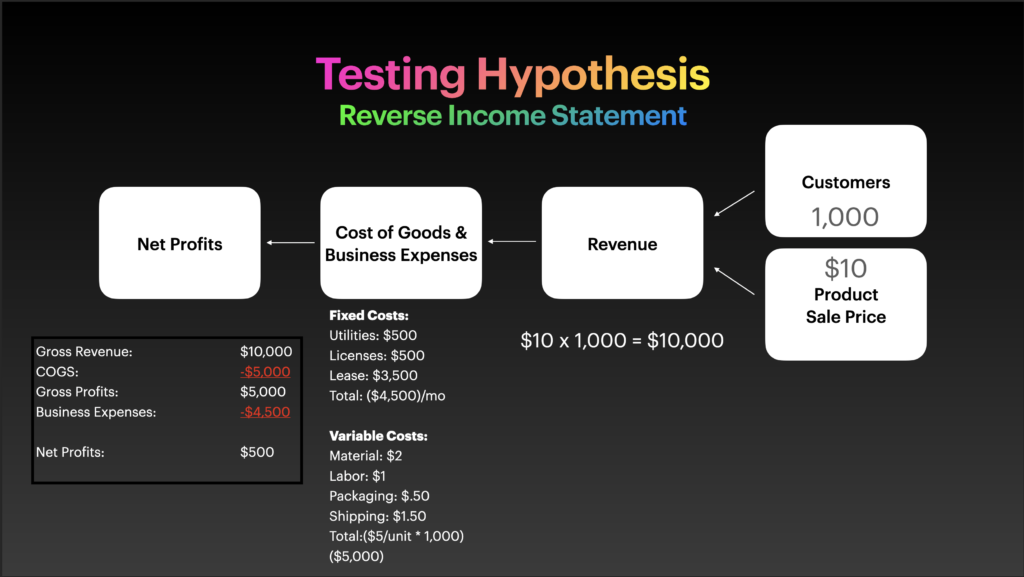
We are selling the physical product for $10 here, and we make the assumption that we can sell about 1,000 items per month. As a result, we bring in $10,000 in gross revenue. Awesome! But, then we need to cover the costs of making those products. Our cost of goods, the cost per unit x total units is $5/unit or $5,000. Right away, our revenue is cut from $10,000 down to $5,000 to cover the costs of making our product. Then we subtract ongoing business expenses, like Utilities, Software licenses, and a building lease. Those expenses total to $4,500/mo. We then subtract those expenses from the money left after covering the cost of making our physical product. $5,000 – $4,500. Uh oh! Now, this is not looking so rosy anymore. From a super exciting $10,000/mo revenue, we are only able to take home $500! Yikes!
You might be wondering how anyone makes any money selling physical products. Well, the business that makes the most money are the ones that have their costs under control – both the cost to build a product and the costs to keep the business running. They also work very hard to have super high sales volumes. With the right mixture of high volume sales and lower costs, you can start to see money coming your way!
So, if you have to pick only one area to focus on, which should it be? Should you focus on increasing sales or reducing costs?
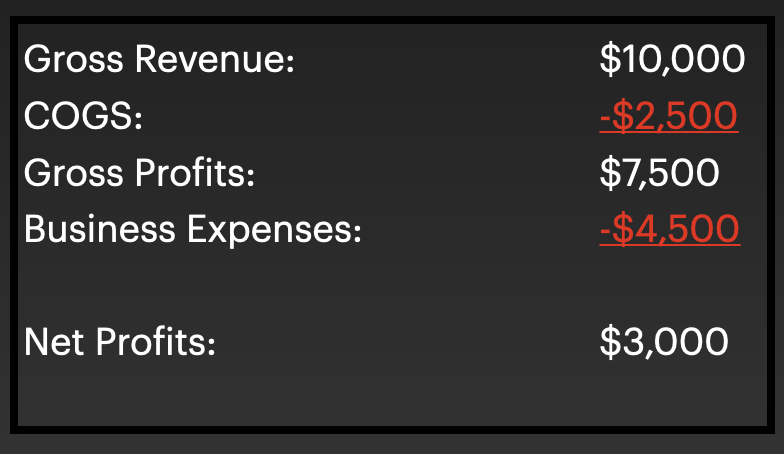
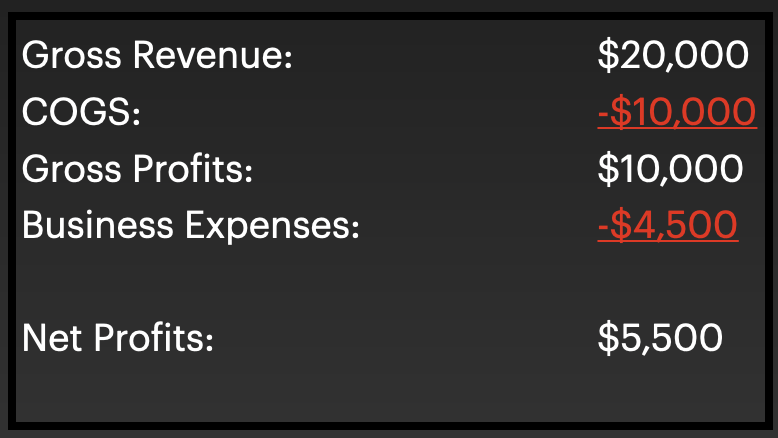
In the first adjustment, we reduced the cost of the product by 50% to $2.50/unit. That resulted in better Net Profits to $3000/mo! In the second adjustment, we kept the costs the same but doubled our sales in the month. That gave us even more profits at the end of the month.
I know I’m over-simplifying things by a huge margin. But the final scenario would be to assume we aren’t able to sell more units and we can’t change the cost structure. What’s the next thing we could do to increase our profits?
You might have guessed it; raise the price. Let’s see what happens when we increase the price by 50% to $15/unit.
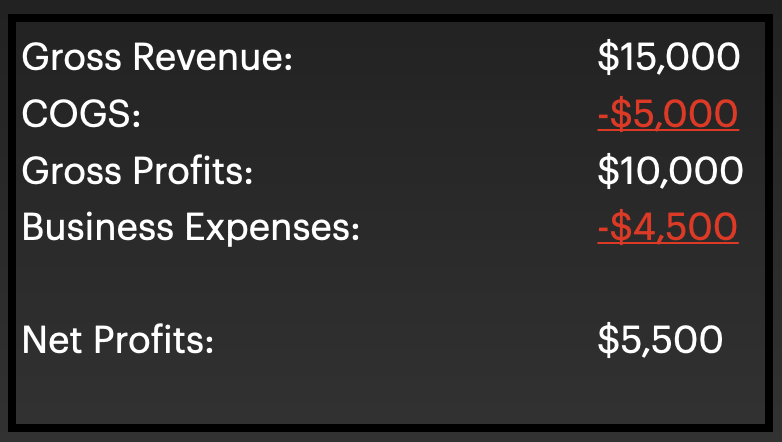
Ok, what?! We just achieved the same profits by increasing the price as we did when we doubled our unit sales. That’s crazy and awesome!
Of course raising the price can negatively impact your total sales, but hopefully you see how important powerful pricing can be when you’re in a situation where your business profits are suffering!
I don’t want to spend too much time showing you how much more money you can make selling non-physical goods. But here is the same chart swapping out the physical good for a digital one that doesn’t have any costs associated with making 1 more unit to sell.
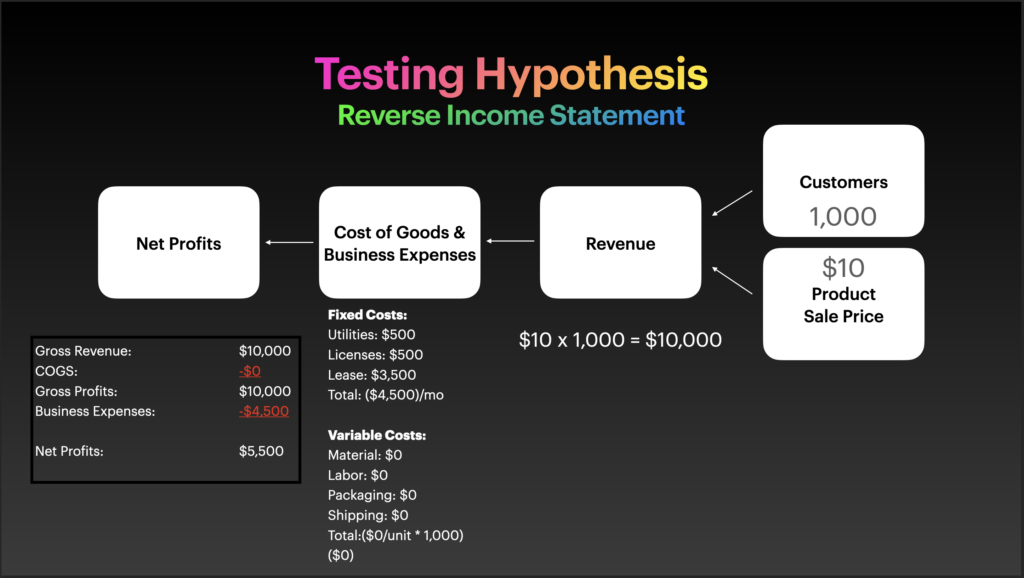
You probably noticed right away a few eye-opening things here. First, the sale price is back to the original $10/unit. Second, the cost of goods is now $0/unit. Finally, the net profits from this situation are the same as our physical goods in the extreme cases outlined. Doubling sales, or increasing price by 50%! But we didn’t double sales, and we didn’t increase the price either. But the profits are the same! Pretty cool, right?!
In a real scenario of selling non-physical goods, you’re product costs actually shift from being unit-costs to additional business expenses. There are also some accounting rules that require you to amortize the cost of developing a non-physical good over a period of time, typically the amount of time equal to the useful life of the digital good. So, you end up with something similar to cost per unit. But you’ll quickly realize that non-physical goods can scale so fast and reach so many people that even measuring costs/unit doesn’t impact the profitability of your business at all. It’s not uncommon for businesses selling digital products to have profit margins that are 80% of their revenue. Imagine taking home $16,000 for every $20,000, instead of the $5,500 profits for physical goods. I’m not biased, digital goods are difficult to make and easy to copy. Physical goods are difficult to make and difficult to copy – because the product is the entire manufacturing process, not just the output. There’s an opportunity in each segment of the market. Knowing how the money flows is helpful in making your decision on what type of business/product will work best for your
Action Item: Do a rough reverse income statement for each of your top business categories. If you need to look online to see what similar items are selling for, go grab that data. For the cost of good and business expenses, put in best-effort analysis to get rough numbers. The goal is to see where the best opportunity lies. One strategy to help you get more reliable data is to keep your business expenses the same for each of the different ideas. In the scientific community, this is called a control. Have your business expenses by the control and the product cost be the variable you are testing.
First Mile Certainty Table
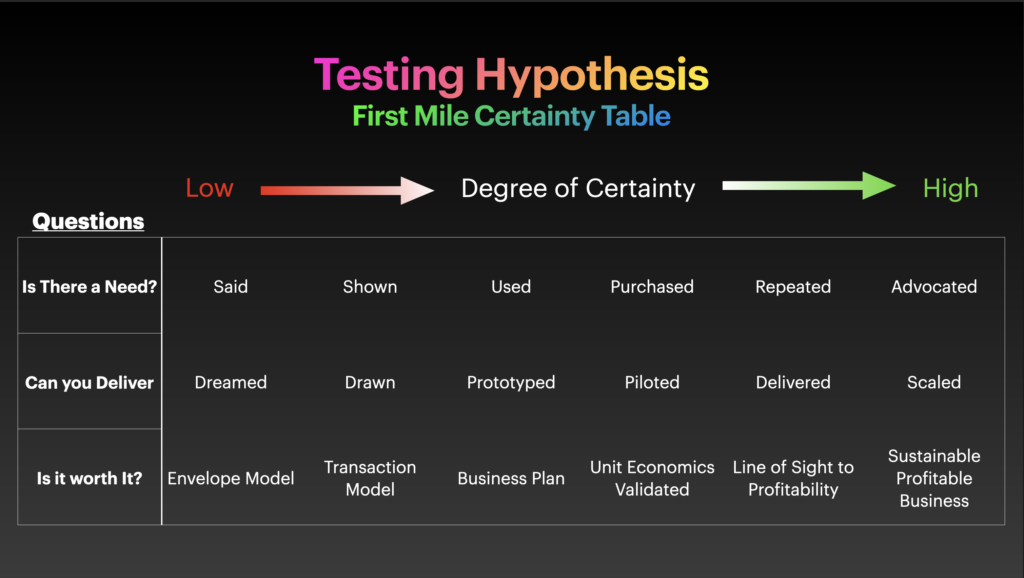
The First Mile Certainty Table can be a gut-check for most, and validating for some. Whichever camp you’re in, the outcome that you have after running your idea through each concept is extremely valuable.
How does the First Mile Certainty table work?
On the left side of the table you have 3 questions stacked vertically. 1. Is there a need? 2. Can you deliver?, and 3. Is it worth it?
Hypothetical answers to these questions are listed left to right with sample responses representing an increase in certainty as you move closer to the right side of the table. Certainty in what? Well, certainty in your business achieving success!
As a result, the business ideas that score the highest are those that you are able to provide answers closer to the right side of the chart.
Let’s walk through an example of how to use the chart for a hypothetical business selling hotdogs out of a food truck – something I have no experience with (but my brother actually did this profitably years ago)
Question 1: Is there a need for a HotDog Selling Food Truck? How intense is that need?
Answer 1: Based on the information (that is very old now) given to me by the owner of a hotdog selling food truck, yes there is a need for this business. There were predictable sales when the truck was at events, but non-recurring events like the country fair made it difficult to have predictable income. The degree of certainty for a hotdog selling food truck is moderate because the customer need falls under “Purchased” on the chart, just shy of “Repeated” since the truck was rarely in the same place at the same time
Question 2: Can you deliver a hotdog selling food truck?
Answer 2: I can imagine what it would take to build a business around a hotdog-selling food truck, but I’ve never actually sat down to write up plans. And I definitely never prototyped a food truck business model of any kind. The degree of certainty on the Can you Deliver equation is very low because I’ve only “Dreamed” or merely thought about it without every writing up plans or creating a prototype.
Question 3: Is it worth it? Does the financial model generate the money you’re expecting?
Answer 3: Conversations I’ve had regarding the economics of the hotdog-selling food truck that my brother operated gave me confidence in the business as far as the “Unit Economics being Validated”. Because there was a clear path to sell the product at a price high enough to cover costs and provide a healthy margin. But true profitability was not something that looked promising enough for me to pursue. The variables that could negatively impact the likelihood of success are very much outside of the control of the business owner. Weather and public event schedules alone quickly present themselves and massive obstacles to predictable and recurring income. Is it worth it? I’m Moderately certain it would be worth it.
Action Item: Ok, now it’s your turn to run your ideas through the First Mile Certain table see how they do! Write down your thoughts and make sure you document why your are scoring the ideas the way that you are. Take into account the answers you gave for the 27 honest questions from earlier. Your answers to that exercise should help you think more clearly about your answers to the questions in the First Mile Certainty table
Your top 5 Ideas
Let’s give your idea list a haircut and trim off the bottom!
Based on your responses in the previous section, remove all ideas from your list except for the 5 ideas that scored the highest on the first-mile certainty test.
If you are even remotely certain you can achieve one of the business ideas you have, then it should be removed from your list.
So, go ahead, pull out the scissors give your list a close trim!
Conclusion
Now that you have your top 5 ideas – and these are actually some pretty good ideas that seem to have some real potential – you’re ready for the next step in the process of narrowing down your list to the one idea that you will move forward with.
Tomorrow we are going to break down how each of your top 5 ideas could make money. This involves knowing more about your customer, more about your offering, more about your operational requirements, and more about your cost structure!
After tomorrow, you’ll have a good idea what different elements will be required to create a business that can repeatedly and reliably service a customer base that not only purchases from you, but advocates for you and your products!
Tomorrow is going to be Amazing! I can’t wait!
